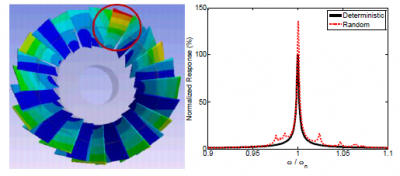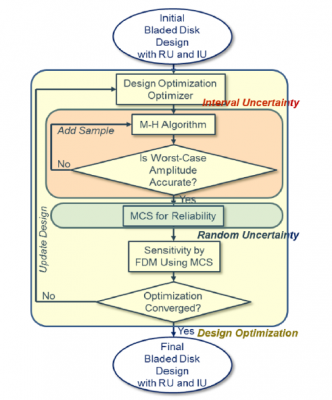Robust design is of critical importance, especially to those structures/systems that are sensitive to uncertainties/imperfections. Spatially periodic structures, e.g., bladed disks in turbomachinery, fall into such category. When the inter-blade coupling is weak, the dynamic response of a bladed disk is very sensitive to the presence of uncertainties. Excessive response variation could be very harmful (Figure 1). Existing studies have indicated that introducing blade-to-blade difference in nominal design, known as intentional mistuning, could reduce the level of response variation. An efficient computational framework that yields the optimal design of intentional mistuning is developed to maximize the bladed disk reliability (Figure 2).

Figure 1. Vibration localization in bladed disk

Figure 2. Reliability-based design optimization
Both the random uncertainty of blades and the interval uncertainty of disk connection are considered. The Metropolis-Hastings algorithm is applied to find the worst-case response under interval uncertainty, and Monte Carlo simulation is employed to account for the random mistuning effect. A gradient-based approach is then established to find the minimum design modification needed to achieve a designated reliability level. The computational framework is shown in Figure 3.

Figure 3. Robust design optimization flowchart
In a case illustration involving two design parameters, τ and φ, that specific the intentional mistuning, we show that we can achieve reliable and robust 2-sigma bladed disk design through design modification.
| Design Modification (%) | Reliability (%) | |||
| 0 | 0.0000 | 0.0000 | 0.00 | 14.6 |
| 1 | 0.0500 | 3.1416 | 12.25 | 43.4 |
| 2 | 0.0899 | 3.1928 | 21.85 | 92.3 |
| 3 | 0.0932 | 3.4582 | 21.76 | 97.5 |
| 4 | 0.0494 | 4.9824 | 11.92 | 96.5 |
| 5 | 0.0511 | 5.0205 | 12.38 | 97.7 |